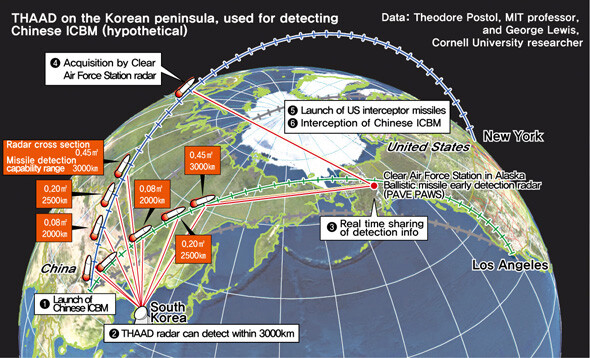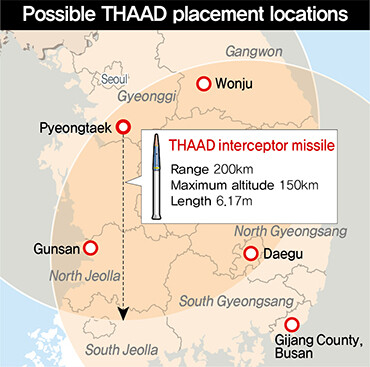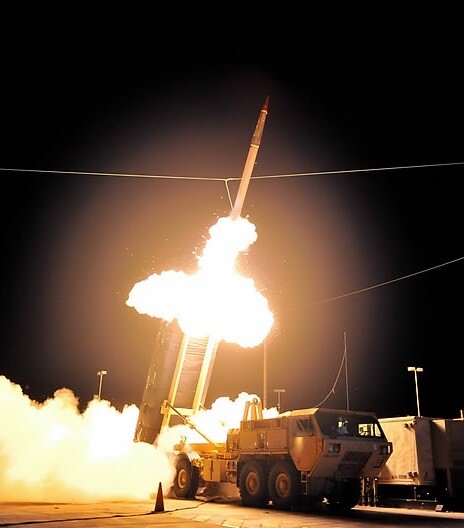hankyoreh
Links to other country sites 다른 나라 사이트 링크
[Analysis] THAAD decision setting of a series of rancorous debates
The debate over the surprise decision to deploy a Terminal High Altitude Area Defense (THAAD) missile defense system with United States Forces Korea (USFK) has touched off new conflicts in and around South Korea.

China in mind?
According to the Ministry of National Defense, the grounds for claiming that the USFK THAAD deployment doesn’t affect China are simple: the system’s key AN/TYP-2 radar component only operates within a left-right azimuth of 120 degrees, which means the system would not affect China if it is positioned toward North Korea. Also, the detection range in terminal-based mode (TBM) would be 600 to 800 km, which would ostensibly reach only as far as the area around the Yalu (Amnok) River on the North Korean-Chinese border.
But Beijing’s concerns go beyond the system’s range. Indeed, China and Russia have both been wary since the time the US announced its missile defense plans in the early ’00s. Their worries center on the damage such a system would do to to their own nuclear deterrence capabilities. From their position, they should be able to retaliate to a hypothetical nuclear attack against them with nuclear weapons of their own - a capability that a missile defense system would undercut. The nuclear balance would collapse, and both countries’ security interests would be jeopardized. It is this situation of conflict between the US on one side and China and Russia that is the root of Beijing and Moscow’s objection to THAAD. It’s also not an issue where Seoul is in a position to win either side over or plead for understanding.
Another factor is the competition between the US and China for power in Northeast Asia. The two countries are already contending with a number of potential causes of military conflict, including Taiwan, territorial issues in the South China Sea, and sovereignty over the Senkaku (Diaoyu) Islands. From the standpoint of this confrontation - which has intensified since Washington introduced its “rebalancing Asia” policy approach - USFK is seen as a spear potentially pointed at China if an emergency erupts. South Korea also reached an agreement with the US in Jan. 2006 for USFK’s “strategic flexibility.” No longer is USFK a “fixture” of South Korea; instead, it is a free military force that can be deployed to battlefields outside the Korean Peninsula. It’s a fact that has made USFK’s activities in Northeast Asia and elsewhere a focus of Beijing’s strategic considerations.
The problem is the restriction on China’s ability to counter USFK once it is armed with a THAAD system. In a 2007 report titled “Entering the Dragon’s Lair,” the US‘s RAND Corporation recommended that the US military prepare for possible Chinese missile attacks against Osan and Kunsan Air Bases.
The Northeast Asian missile defense framework also looks to be headed toward a system of trilateral integration among South Korea, the US, and Japan. The system is now poised to be linked up for military information sharing sometime this year. The inevitable impression for Beijing is that the USFK THAAD deployment means missile defense is serving as the cornerstone for increase trilateral security cooperation against it.
The utility of THAAD

The Ministry of National Defense has also said THAAD’s capabilities have been “proven,” with “successful results in all 14 test evaluations conducted so far.” But many dispute the findings of those evaluations, which have been supervised by the US Defense Department.
“There wasn’t any evaluation under actual fighting conditions - the test evaluations consisted of intercepting a missile that had been launched out of a cargo aircraft via parachute,” said military affairs critic Kim Jong-dae, raising questions about the findings’ reliability.
Even US military authorities have recognized the THAAD system‘s shortcomings. An annual report released last month by the Pentagon’s Director, Operational Test and Evaluation (DOT&E) pointed out problems related to the radar-operator interface and launch pad. The DOT&E also noted that 18 of 39 areas for improvement cited in 2012 remain unaddressed, with modifications and testing planned for the 2017 accounting year. The current rush to deploy a flawed weapon system is turning the peninsula into a testing ground - and an arena for the competition between rival powers.
At present, North Korea is estimated to have somewhere between 800 and 1,000 ballistic missiles. Most operate on liquid-propellant rocket engines. Launches involve a time-consuming fueling process, with only the KN-02 available as a solid-propellant rocket for immediate launch. The KN-02 is difficult for THAAD to intercept, with a range of around 150 km and a maximum altitude of approximately 40 km. The system is also helpless in the face of long-range artillery, which poses an even greater threat than missiles.
Deployment of THAAD is also likely to lead to a runaway arms race. Last year, North Korea successfully conducted an ejection test on a submarine-launched ballistic missile. Those efforts could be intended to develop the capabilities to fire missiles from the rear area of South Korea while avoiding the missile defense network. A competition between “spears” and “shields” now looks unavoidable - and shields will require an astronomically greater investment from South Korea than spears. It‘s an asymmetrical case of runaway competition that could prove very costly in the long run.
Electromagnetic waves damaging to health and environment?

The US military technical manual lists a maximum distance of 5.5 km within a 130-degree range as the danger radius for electromagnetic waves from THAAD’s AN/TYP-2 radar system. The South Korean Ministry of National Defense maintains that there should be no negative effects to human health or the environment from the waves as long as these specifications are observed.
“My understanding is that the level of electromagnetic waves around the THAAD radar accords with the safety levels specified by domestic law and the World Health Organization,” said one ministry official.
“As long as the generators are used during emergency situations and commercial electricity is used normally, there shouldn‘t be any noise issues,” the same official added.
The official also noted that a June 2015 environment impact assessment on Guam’s THAAD system showed damages from the radar‘s electromagnetic wave to “only apply within a range of 100 meters.”
But the same report notes that US authorities also had to damage 144,000 square meters of forest to establish a site for THAAD. The possible extinction of some wild animal and plant life was reported as another risk. A June 2015 reportage in the Hankyoreh written after a visit to the area around Japan’s Kyogamisaki Sub-Base, where THAAD radar has also been deployed, found local residents complaining of health and environment damages from the powerful electromagnetic waves for six months after the radar went into operation. The Japanese government called the idea of negative effects “unthinkable,” noting that the residents were to the rear of a radar system pointed out to sea. Residents, who have consistently opposed the radar’s deployment, countered that the health effects from the waves are “not easy to detect because they occur gradually over a long period of time like with radiation, and a causal relationship with health damages is difficult to prove.”
The residents predicted that the government would continue arguing that there are “no effects.”
By Park Byong-su, senior staff writer and Kim Ji-eun, staff reporter
Please direct questions or comments to [english@hani.co.kr]

Editorial・opinion
![[Column] Has Korea, too, crossed the Rubicon on China? [Column] Has Korea, too, crossed the Rubicon on China?](https://flexible.img.hani.co.kr/flexible/normal/500/300/imgdb/original/2024/0419/9317135153409185.jpg) [Column] Has Korea, too, crossed the Rubicon on China?
[Column] Has Korea, too, crossed the Rubicon on China?![[Correspondent’s column] In Japan’s alliance with US, echoes of its past alliances with UK [Correspondent’s column] In Japan’s alliance with US, echoes of its past alliances with UK](https://flexible.img.hani.co.kr/flexible/normal/500/300/imgdb/original/2024/0419/2317135166563519.jpg) [Correspondent’s column] In Japan’s alliance with US, echoes of its past alliances with UK
[Correspondent’s column] In Japan’s alliance with US, echoes of its past alliances with UK- [Editorial] Does Yoon think the Korean public is wrong?
- [Editorial] As it bolsters its alliance with US, Japan must be accountable for past
- [Guest essay] Amending the Constitution is Yoon’s key to leaving office in public’s good graces
- [Editorial] 10 years on, lessons of Sewol tragedy must never be forgotten
- [Column] A death blow to Korea’s prosecutor politics
- [Correspondent’s column] The US and the end of Japanese pacifism
- [Guest essay] How Korea turned its trainee doctors into monsters
- [Guest essay] As someone who helped forge Seoul-Moscow ties, their status today troubles me
Most viewed articles
- 1[Column] The clock is ticking for Korea’s first lady
- 2After 2 months of delayed, denied medical care, Koreans worry worst may be yet to come
- 3[Column] Has Korea, too, crossed the Rubicon on China?
- 4US overtakes China as Korea’s top export market, prompting trade sanction jitters
- 5[Correspondent’s column] In Japan’s alliance with US, echoes of its past alliances with UK
- 6Hong Se-hwa, voice for tolerance whose memoir of exile touched a chord, dies at 76
- 7All eyes on Xiaomi after it pulls off EV that Apple couldn’t
- 8[News analysis] After elections, prosecutorial reform will likely make legislative agenda
- 9More South Koreans, particularly the young, are leaving their religions
- 10John Linton, descendant of US missionaries and naturalized Korean citizen, to lead PPP’s reform effo